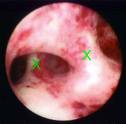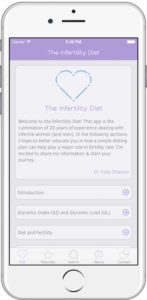Office Hysteroscopy
A hysteroscopy is a test that lets your doctor examine the inside walls of your uterus. The procedure is done in our accredited Ambulatory Surgery Center (ASC) on site. Our ASC has been accredited by the American Association for Accreditation of Ambulatory Surgery Facilities (AAAASF) since 2006.
Having an abnormality in your uterus can reduce your chances for pregnancy. A hysteroscopy is a test that uses sterile salt water and a tiny telescope to visualize the inside of your uterus. The test is able to detect scar tissue (see photo below), polyps, fibroids, and any uterine abnormality such as a septate uterus, that may prevent an embryo from implanting properly.
|
Uterine adhesions (Asherman’s syndrome)
|
Picture of a normal uterus
|
What to expect during the office hysteroscopy
The hysteroscopy is usually done in our office and takes about 30 minutes. A speculum is inserted into your vagina (like when you have a Pap smear). A local anesthetic is then given, and then a tiny telescope with a camera is placed through your cervix into the uterine cavity. The sterile salt water is instilled into the uterus so that you can see the walls. There is a TV monitor allowing you and your doctor to visualize the inside of the cavity. We have the latest in office hysteroscopy equipment, including a 3.9 mm hysteroscope which results in significantly less patient discomfort compared to the older 5 mm hysteroscopes, and usually allowing no need to dilate the cervix.
Questions and Answers
Q: A friend of mine had a hysteroscopy and she said it was uncomfortable. Is that true?
A: Many women feel some cramping, especially when the sterile salt water is instilled. Women with blocked fallopian tubes may feel more uncomfortable. Even though we are using the smallest hysteroscope available, We do recommend that one hour before the procedure you take 2-3 pills of regular ibuprofen (Motrin, Alleve) to help prevent or reduce cramps during the procedure.
Q: Is it OK to drive home by myself after the test?
A: Many women have no pain after the hysteroscopy, but you may feel a little cramping. You should be able to drive yourself, and return to work after the procedure.
Q: What are the risks of a hysteroscopy?
A: The risks of the hysteroscopy include pain or discomfort, infection, and vaginal spotting or bleeding. Contact your doctor if you develop a fever, continue bleeding, or continue to feel pain. We have not had any infections or other complications in more than 1000 cases to date. You may have some spotting for 2-3 days after the procedure.
Q: When is the best time during my cycle to schedule the hysteroscopy?
A: You should call the office with the first day of full flow so that we can schedule the test. The hysteroscopy is usually scheduled after your period ends, but before you expect to ovulate, usually between days 6-12 of your menstrual cycle. You need to use protection during intercourse prior to the test. You may resume intercourse without protection 24 hours after the procedure.
Contact us to learn more about office hysteroscopy.




